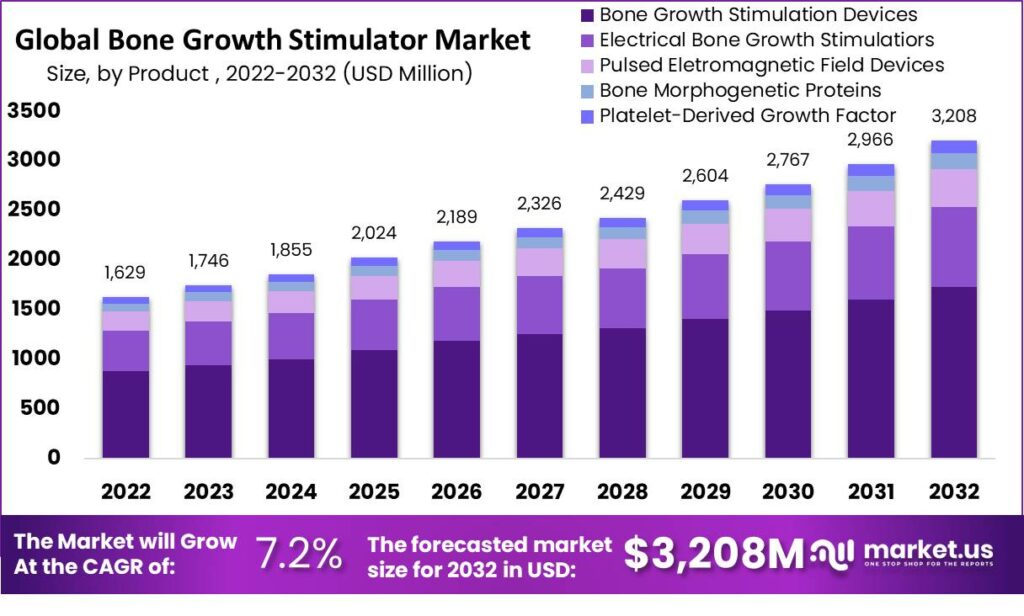Table of Contents
Introduction
The Global Bone Growth Stimulators Market is poised for robust growth, with projections indicating an increase from USD 1,629 million in 2022 to USD 3,208 million by 2032. This represents a compound annual growth rate (CAGR) of 7.2% over the forecast period from 2023 to 2032. Key drivers include technological innovations and increased clinical adoption due to the effectiveness of these devices in bone healing.
Technological advancements are central to the market expansion. Notably, the introduction of Low-Intensity Pulsed Ultrasound (LIPUS) devices marks a significant innovation. These non-invasive stimulators utilize ultrasound technology to expedite the healing process in cases of nonunion and delayed union fractures. The ongoing development of such technologies enhances the efficacy and appeal of bone growth stimulators within the medical community.
The adoption of bone growth stimulators has also been bolstered by updated clinical guidelines which recommend their use in specific nonunion fractures where traditional treatments have failed. This growing clinical endorsement is supported by insurance coverage, including Medicare, under certain conditions, thereby increasing accessibility and usage in orthopedic practices.
Economically, bone growth stimulators offer substantial benefits. They reduce the necessity for surgical interventions, which, in turn, lowers overall healthcare costs. Economic analyses suggest that using LIPUS devices can significantly cut costs associated with nonunion fractures compared to surgical options. This cost-effectiveness is a vital factor driving broader adoption in the healthcare sector.
Regulatory support further enhances market growth, with approvals from health authorities such as the FDA and the inclusion of these devices in medical treatment protocols. Updated medical necessity criteria and insurance guidelines now accommodate bone growth stimulators, extending their reach to a wider patient demographic. This regulatory landscape supports market confidence and investment in new technologies.
The market is set to expand significantly, fueled by increasing demand in areas with high incidences of osteoporosis and fractures, particularly in an aging global population prone to bone ailments. The integration of innovative, cost-effective medical devices that improve patient outcomes is critical to the ongoing growth and evolution of the bone growth stimulator sector.

Key Takeaways
- The bone growth stimulators market is expected to grow by 7.2% annually, reaching US$ 3,208 million by 2032.
- Non-invasive devices lead the market, holding a 54% share.
- Spinal fusion surgeries are prominent, mainly due to rising spinal disorders.
- Hospitals and clinics dominate the market with a 38% share, attributed to frequent patient visits.
- Increasing cases of bone diseases like osteoporosis significantly drive market growth.
- Orthopedic treatments using platelet-rich plasma offer substantial growth opportunities.
- There’s a shift towards non-invasive stimulators using ultrasound and magnetic technology.
- North America leads with 40% of the market revenue, driven by high osteoporosis rates and healthcare spending. Europe also shows significant market potential.
- Bone Growth Stimulators Market Key Players: Medtronic plc, Zimmer Biomet, DePuy Synthes, Orthofix Holdings Inc., Bioventus LLC., Arthrex Inc., Terumo Corporation, Stryker Corporation, Ossatech Benelux B.V., BTT Health GmbH, Orthofix Medical Inc., and Other Key Players
Emerging Trends
- Anabolic Therapies for Osteoporosis: A notable development in osteoporosis treatment involves anabolic therapies that stimulate bone growth. Romosozumab (Evenity) represents a new class of drugs that not only increase bone formation but also reduce bone resorption. This therapy is especially beneficial for postmenopausal women who are at a high risk of fractures. The dual action of romosozumab offers a promising approach to managing severe osteoporosis effectively.
- Hormonal Advances for Bone Density: Recent research has identified a new hormone known as Maternal Brain Hormone (CCN3), which shows potential in enhancing bone density and strength. This discovery during breastfeeding research suggests that CCN3 could be pivotal in treating osteoporosis and aiding the healing of bone fractures. Its implications for improving bone health are substantial, indicating a potential breakthrough in hormonal treatments for bone-related ailments.
- Innovations in Bone Graft Materials: Advances in bone healing technologies have been made at Texas A&M University, where researchers have developed bone grafts from primitive stem cells. These grafts have proven to accelerate the healing process more effectively than traditional methods. They are particularly useful in complex fracture cases where normal healing is impeded. This innovation could revolutionize treatments for severe fractures by enabling quicker recovery and better support for bone regrowth.
Use Cases
- Osteoporosis Management: Bone growth stimulators are revolutionizing the treatment of osteoporosis. Notably, romosozumab, a new pharmacological option, significantly boosts bone density. Studies indicate it can enhance bone density by up to 15%, mirroring levels typically seen in healthy teenagers. This breakthrough is particularly promising for patients at high risk of fractures, offering a non-invasive solution to strengthen bones effectively.
- Nonunion Fracture Treatment: Electrical and ultrasound bone growth stimulators are showing promising results in treating nonunion fractures. These technologies are helping to avoid costly surgeries by promoting quicker healing. For example, using stimulators has demonstrated a reduction in healthcare expenses by managing complications more efficiently and accelerating the healing process. This approach is increasingly recognized as a cost-effective treatment option in orthopedic care.
- Post-surgical Recovery: Bone growth stimulators play a crucial role in post-surgical recovery, especially following spinal surgeries. These devices are used to speed up the healing process, improving patient outcomes. By enhancing bone regeneration, they help to reduce the likelihood of reoperations. This use of stimulators ensures a faster return to normal activities, significantly benefiting patient recovery trajectories.
- Reducing Long-term Dependency on Medication: Bone growth stimulators are instrumental in minimizing the need for prolonged medication use, including opioids. By improving bone healing and shortening treatment durations, these devices help manage pain more effectively. This not only leads to better patient health management but also contributes to reducing overall healthcare costs associated with long-term drug therapy. This approach is particularly important in combating the opioid crisis by providing an alternative pain management strategy.
Regional Analysis
North America holds a notable 40% share of the bone growth stimulator market. This significant share is primarily attributed to the high prevalence of osteoporosis in the region. Bone growth stimulators are increasingly used to manage and treat bone-related disorders, supported by substantial healthcare investments.
Take advantage of our unbeatable offer - buy now!

The region benefits from extensive healthcare spending, which underpins the widespread use of these devices. This financial commitment aids in addressing various bone disorders that require therapeutic intervention through bone growth stimulators. The approach is integral to managing conditions associated with bone health.
Additionally, the high incidence of bone disorders in North America necessitates robust medical procedures. These procedures often involve the use of bone growth stimulators, contributing to the large market share observed in this region. The technology plays a critical role in orthopedic treatments, enhancing patient outcomes.
Europe is also expected to witness considerable growth in the bone growth stimulator market during the forecast period. The expansion is anticipated due to contributions from both leading and emerging companies within the market. These entities are expected to drive innovation and accessibility in the region, fostering market growth.
Key Players Analysis
Medtronic plc
Medtronic plc is a prominent player in the bone growth stimulator sector, leveraging its expertise to address bone health challenges. Their devices, often used post-spine surgery or to heal broken bones, enhance the bone healing process by emitting low-level pulses of electromagnetic energy, promoting bone growth and repair. This technology is particularly significant for patients at high risk of non-union fractures, where bones fail to heal naturally. While specific numerical data on Medtronic’s market share or sales figures in this sector were not available from government or educational sources, the general application of bone growth stimulators underscores their critical role in orthopedic and rehabilitative medicine. This approach by Medtronic not only highlights its innovation trajectory but also its commitment to improving patient outcomes in bone health-related conditions.
Zimmer Biomet
Zimmer Biomet is a prominent player in the bone growth stimulator market, offering devices like the Biomet® OrthoPak® Non-invasive Bone Growth Stimulator System. This system is designed to treat established nonunions resulting from trauma, excluding vertebrae and flat bones, where the nonunion gap is less than half the bone’s width. The OrthoPak® delivers continuous therapeutic electrical signals to the fracture site, promoting healing over a recommended 24-hour daily usage for up to 270 days. Notably, the device is lightweight, weighing only 3.15 ounces, enhancing patient comfort during prolonged use. Clinical studies have reported healing rates as high as 83.3% with this system. Zimmer Biomet’s commitment to innovation and patient care has solidified its reputation in the bone healing sector.
DePuy Synthes
DePuy Synthes, a part of Johnson & Johnson, offers the SpinaLogic Bone Growth Stimulator, a portable, battery-powered device designed to support spinal fusion procedures. This stimulator emits low-level electromagnetic pulses to the fusion site, promoting bone healing and reducing the risk of nonunion. Studies have shown that electrical stimulation can enhance spinal fusion success rates, making devices like SpinaLogic valuable for patients undergoing such surgeries. Additionally, DePuy Synthes has developed the PROTI 360° family of implants, which combine polyetheretherketone (PEEK) and titanium to encourage bone growth and improve spinal fusion outcomes. These innovations highlight DePuy Synthes’ commitment to advancing bone healing technologies in the orthopedic sector.
Orthofix Holdings Inc.
Orthofix Holdings Inc. is a leading medical device company specializing in bone growth stimulators. Their non-invasive devices, such as the SpinalStim™, CervicalStim™, and PhysioStim™, utilize pulsed electromagnetic field (PEMF) technology to promote bone healing in fractures and spinal fusions. Notably, Orthofix’s bone growth therapy devices are the most prescribed in the U.S., with over one million patients treated to date. Clinical studies have demonstrated high success rates; for instance, the SpinalStim™ device achieved a 92% fusion rate in lumbar spinal fusion patients, compared to 68% in those without the treatment. Orthofix continues to innovate in this sector, offering effective solutions for patients with bone healing challenges.
Bioventus LLC.
Bioventus LLC specializes in bone growth stimulation, notably with their EXOGEN Ultrasound Bone Healing System. This device uses low-intensity pulsed ultrasound to promote the body’s natural bone healing processes. Clinical studies have shown that EXOGEN can accelerate healing of certain fresh fractures by 38% and achieve an 86% success rate in treating established nonunions. Treatment involves a daily 20-minute session, which patients can conveniently perform at home. Over the past 25 years, EXOGEN has been prescribed to more than a million patients worldwide. The device is approved by the U.S. Food and Drug Administration (FDA) and is covered by most major health insurers for indicated fractures.
Arthrex Inc.
Arthrex Inc. is a key player in the bone growth stimulator market, offering a range of orthobiologic products designed to enhance bone healing. Their AlloSync™ bone grafts provide a scaffold that supports new bone formation, aiding in the repair of bone defects. Additionally, Arthrex’s ArthroCell™ viable bone allograft contains living cells and a supportive framework to promote bone regeneration. These products are utilized in various orthopedic procedures to improve patient outcomes.
Conclusion
The Bone Growth Stimulator Market is expanding due to rising demand for non-invasive treatments, technological advancements, and increasing adoption in orthopedic care. Innovations such as ultrasound and electromagnetic devices are improving bone healing, reducing surgical interventions, and enhancing patient recovery. Clinical guidelines now support these stimulators, making them a preferred choice in treating fractures and spinal fusions. Regulatory approvals and insurance coverage further boost market accessibility. Growth is also fueled by an aging population and a higher incidence of bone disorders. With continuous research and improved healthcare investments, bone growth stimulators are becoming an essential part of modern orthopedic treatments, offering effective and cost-efficient solutions for enhanced patient outcomes.
Discuss your needs with our analyst
Please share your requirements with more details so our analyst can check if they can solve your problem(s)



